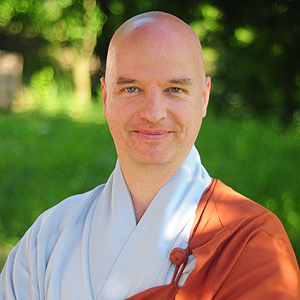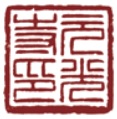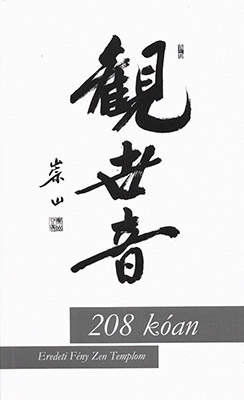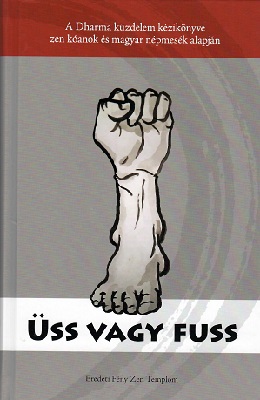ZEN MESTEREK ZEN MASTERS
« Zen főoldal
« vissza a Terebess Online nyitólapjára

청안 / 淸眼 Cheong An (1966-)
aka Chong An Sunim
(Magyar átírás:) Cshong An (= Csong An szünyim); eredeti neve: Virágh Szabolcs
Csong An Szunim
1966 szeptemberében született Budapesten. A zennel egy barátja ajánlására találkozott 1990-ben. Szung Szán zen mestert Budapesten ismerte meg 1991-ben. Világiként gyakorolt 1994-ig, amikor szerzetesi fogadalmat tett, és Szung Szán zen mestertől a ‘Csong An' = ‘tiszta szem' nevet kapta. Hat évig tartózkodott folyamatosan Koreában, ezalatt tizenkét 90 napos és egy 100 napos meditációs gyakorlatot végzett el. Mestere 1999-ben avatta tanítóvá, ebbéli működését 2000-ben kezdte meg, mely mára már Ázsiában, Európában és az USA-ban is visszhangra talált. A budapesti Kvanum Zen Iskola egy korábbi része 2012 áprilisától Eredeti Fény Zen Közösség (원광사 / Von Gvang Sza) néven él tovább Csong An Szunim vezetésével. Koreában televíziós és nyomtatott formában egyaránt népszerűvé vált tanítása. Nevével fémjelezve három könyv jelent meg: ‘The Flower and the Bee', ‘Mind Mirror', ‘How May I Help You?'.

元光寺 — Won Kwang Sa — Original Light Zen Temple
Eredeti Fény Zen Közösség és Templom
2500 Esztergom, Búbosbanka utca 61.
http://eredetifeny.hu
www.wonkwangsa.net
„1966-ban születtem Budapesten, orvos szülők gyermekeként. Erre nagy szükség is volt, amikor szerzetesként ezt a kérdést szegezték nekem: ‘Orvos látott?' Ekkor boldogan tudtam azt mondani, hogy ‘igen', mert boldog gyermekkorom volt.
1991 áprilisában látogatott Szung Szán zen mester hazánkba másodszor és utoljára. Kétszer tettem föl neki kérdést publikusan, és kétszer válaszolt teli bölcsességgel, együttérzéssel, erővel - és humorral. Nem volt kérdés, hogy ki lesz a tanítóm.
Hat évet töltöttem Hvagjeszában fiatal szerzetesként, Szöul egyik patinás templomában, Szung Szán zen mester avatott tanítóvá 1999-ben. 2002-ben a sok megfontolás egy irányba mutatott: a koreai kapcsolatok fejlesztése mellett itthon kell megpróbálni. Ez azt jelentette, hogy 2003-ban elindult a keresés megfelelő templomi föld iránt. 2004-ben találtuk meg, 2005-ben kezdtünk vásárolni, 2006-ban építkezni, és 2010-ben megnyitottuk a hagyományos stílusú zen termünket.
2011-ben otthagytam azt a nyugati ernyőszervezetet, amely a hagyomány és köztem állt. 2012-ben követte a magyar szangha többsége a döntésemet, így a templom is. Ma Szung Szán zen mester eredeti monasztikus családjába tartozunk közvetlenül, sok jó kapcsolattal és lassan, de biztosan növő közösséggel.”
http://everness.hu/program-2639/eloadok/chong-an-sunim
Fordítások:A Zen : Szung Szán zen mester tanítása. Ford., szerk. és vál. Szigeti György : A Tanátadási beszéd című fejezetet és Az ember útja című verset ford. [Virágh Szabolcs] Csong An Szunim : Az ember útja és az Ezen a világon mindenki őrült című fejezeteket ford. Erdődy Péter és Szigeti György. Budapest : Farkas Lőrinc Imre Kiadó, 1997. 109 p. ISBN 963 7210 18 5
Budapest Zen Központ Megnyitó Ceremónia. [Szertartásfüzet]. Összeáll. [Virágh Szabolcs] Csong An Szunyim. Budapest : Kvanum Zen Iskola Magyarországi Közössége, 2000. [20 számozatlan oldal]. nincs ISBN szám
Buddha Megvilágosodásának Ünnepe : Buddha Szemnyitó Szertartás. [Szertartásfüzet]. [Ford. Csong An Szunyim]. Budapest : Kvanum Zen Iskola Magyarországi Közössége, é.n. 29 p. nincs ISBN szám
Szertartás az eltávozás negyvenkilencedik napján. [Szertartásfüzet]. [Ford. Csong An Szunyim]. Budapest : Kvanum Zen Iskola Magyarországi Közössége, [é.n.]. 20 p. nincs ISBN szám
[Sung San Haeng Wŏn, 숭산행원 , 崇山行願 ] Szung Szán zen mester: Hamut a Buddhára. Ford. Szigeti György, Sólyom Melinda, Hörcher Péter, Virágh Szabolcs. Budapest : Kvanum Zen Iskola Magyarországi Közössége, [2005]. (Dropping Ashes on the Buddha : The Teaching of Zen Master Seung Sahn). 259 p. ISBN 963 7310 46 0

208 kóan. Fordította: Csong An Szunim, Eredeti Fény Zen Templom, 2019, második kiadás. 244 oldal.
(A kiadás alapja Szung Szán zen mester tanítása: 1994-99 közötti hangfelvételek, Hvangjesza Templom, Szöul, Dél-Korea)
> a 2021-es kiadás címe: Küzdj és ébredjCímlap: 観世音 „Kvan Sze Um — Halld meg a világ hangját” — Avalókitésvara, a cselekvő együttérzés és segítő odafordulás bódhiszattvája. Szung Szán mester kalligráfiája.

Üss vagy fuss. A Dharma küzdelem kézikönyve zen kóanok és magyar népmesék alapján. Szerkesztő: Virágh Szabolcs. Eredeti Fény Zen Templom. 2020, 206 oldal66 Dharma küzdelem — 22 magyar népmese
Király Attila: Tigrisek az Úton - avagy egy budapesti zen buddhista közösség
In:
Kisebbség és kultúra (Antropológiai tanulmányok; 1.),
szerk. A. Gergely András, Papp Richárd, 180-201. oldal
http://mek.oszk.hu/06800/06818/
![]()
Chong An Sunim
https://web.archive.org/web/20160116024116/http://sweepingzen.com/chong-an-sunim/
Chong An Sunim started Zen pracitce in the Kwan Um School of Zen in 1990. He became a monk in 1994, and spent the next six years training under Zen Master Seung Sahn at the Seoul International Zen Center, Korea. He received inka on August 26, 1999, from Zen Master Seung Sahn, becoming the first Hungarian to be given the authority of Ji Do Poep Sa Nim in the history of Korean Buddhism.
Since 2000, his primary residence has been in Europe. Based at Bo Kwang Soen Won between 2000-2008, Budapest, Hungary, he has been teaching extensively in Buddhist countries of Asia like Korea, Singapore, and Malaysia. As a member of the European Teachers' Group of the Kwan Um School of Zen, he has kept a vibrant schedule to visit European countries like the Czech Republic, Slovakia, Poland, Russia, Sweden, Norway, the United Kingdom and Austria.
In 2003, Chong An Sunim initiated the search for land to construct a traditional style Korean temple in the Pilis Mountains, near Budapest. As part of the Kwan Um School of Zen, the teaching lineage transmitted by Zen Master Seung Sahnto the west, it is intended as residence for Sunims and lay people who want to do extensive training as well as short term retreats.
The temple site was found a year later in 2004, and the first piece of land was purchased in 2005 February. With ever widening support from the international Sangha, land acquisition continues to the present day. The first, temporary Dharma room was opened in 2006, the kitchen and other auxiliary buildings became operational at the end of that year. The first short retreat took place in 2006, the first long retreat, Winter Kyol Che, was done following the solar calendar, between 2007 January and April.
In 2008, Chong An Su Nim moved to Won Kwang Sa. The second Winter Kyol Che in 2009 was held under his guidance as well, this time with three guest teachers present. Construction of the main temple buildings was started in 2009 August and finished in less than six months . The Opening Ceremony for the first Zen Hall was performed on April 4th 2010.
There has been two books published under his name, “The Flowers and the Bee' (2007) and ‘Mind Mirror' (2009) with Gimm Young Publisher, Inc. He has given several Dharma Talks since 2006, later broadcast and streamed by BTN, the Buddhist Television Network of Korea. BTN has visited Hungary several times and made a documentary on the beginnings of the Won Kwang Sa project entitled “Flowers on Virgin Soil”. Chong An Sunim's third book entitled ‘One Mind, One Chance' is to be released in May 2011 by Dasan Publishers.
Books
“The Flowers and the Bee' (2007) (Gimm Young Publisher, Inc.)
‘Mind Mirror' (2009) (Gimm Young Publisher, Inc.)
‘One Mind, One Chance' (May 2011) (Dasan Publishers)
Inka Speech
by Chong An Sunim, JDPS
https://web.archive.org/web/20050310011142/http://www.kwanumzen.com/primarypoint/v18n1-2000-winter-chongan-inkaspeech.html
Raises Zen stick over head, then hits table with stick.
Sound is silence. Silence is sound.
Raises Zen stick over head, then hits table with stick.
No sound, no silence.
Raises Zen stick over head, then hits table with stick.
Sound is sound. Silence is silence. What is original sound?
KATZ!
Hear the moktak hitting and the women chanting in the ceremony hall.
This story is about sounds, music and voices I have heard in my life. My good old friend Zoli and I loved drumming. We got congas when we were eighteen and drove the neighbors through the roof with our rhythm. We were completely crazy about it, and had great parties where instead of some commercial tape a group of youth drummed, danced and loved each other very much.
One day Zoli brought great news: He was hired by an avant-garde theater to give percussion to their music. The play was an old Greek drama, full of passion, suffering and tragedy. He invited me to the performance, promising that we would have the greatest drumming experience. We did. I got enthralled by the energy of the place, the radiation of the group, the intensity of their acting.
A few weeks later I saw a poster announcing the start of a new studio class in the theater. Without thinking, I made up my mind and gave it a try. I was accepted, and twice a week ten of us trained together to become actors. It was action theater with simple instructions and no theories--you had to bring everything out of yourself.
At the end of the season, we took an exam. Eight people finished the course and were invited to a remote house in the countryside for a weekend workshop. This turned out to be a shamanistic trip led by the director, super-drumming for a long time, dancing around the fire, raising tremendous amounts of energy and sending our minds to places we had never gone before.
Afterwards, I felt extremely strong, with sharp, clear perception and the strength to carry out anything I wanted. It was Spring 1990. I was 24. I had been looking for a spiritual way for a long time, but in the summer I began to feel doubt that what I had found was going in the correct direction. I met the director in his apartment and asked him several questions: "What is the purpose of this practice? What kind of karma do we make by doing it?" He said, "You will not find the answer in religion, psychology or philosophy." His energy changed from supportive to repressive. I felt a tremendous push as if somebody wanted to crush me; then tension, anxiety, and helplessness. These feelings did not leave me for many weeks.
Summer wore on. I talked to several friends about my doubts and depression. One of them suggested that I should go and see a Zen group, that there I might find the answer to my questions. It was the Hungarian sangha of the Kwan Um School of Zen. I went there, and what I got was not answers. It was our practice form, the very tool that enables us to find any answers we want, independent of anything or anybody.
Later, in September, the theater season began again and I was still worried and anxious about what I was doing, where my life was going. As the first rehearsal began, I saw a moktak among the drums. I never told anyone in the theater about Zen. How could it get there? Did somebody perceive my mind so deeply? I felt I was in trouble, without any defense. I decided to leave.
The director took my notice with a plain face and told me, "People can do this only three times in their lives." Next day I was back, moving and acting at the sound of the drum. That day, while going home, I heard one voice in my consciousness: "Do you want to be free? Or a slave?" I gathered my strength again and never went back to the theater any more.
That fall, I was exhausted all the time. My nights were horrible. Voices were screaming in my head. My body, speech and mind were separating. While I was thinking about something, my mouth said another, and my body did something else. I felt my life was disintegrating, my self going down into the deepest hell.
I had a choice: either I went to a mental hospital or tried to get out of this myself. From before, I knew the teaching that our mind creates the whole world, but I had no experience how it works. One thing I knew: I must do it myself. I had seen enough psychiatric wards not to want to go in there. So, I kept going to the weekly meetings of my sangha, bowing every morning at home and sitting with splitting headaches. I did a lot of sports. In spite of my efforts, I felt I was going into a dark, murky winter with no spring coming.
In December 1990, Do Am Sunim JDPS came to Budapest and held a Yong Maeng Jong Jin. He was strong and clear. That weekend swept away the thick clouds for a short while and the light at the end of the tunnel appeared for a moment. Then I knew: I was on the right track, I just had to keep going, digest my karma and become completely clear.
Early the next year Zen Master Seung Sahn visited Budapest. I had the fortune to meet him, ask him questions, and get beaten in dharma combat. This strengthened my resolve to keep on the path and practice more.
Three years passed. I graduated, got a job, had a girlfriend, and was attending my first 90-day retreat at Diamond Hill Zen Monastery in 1994. That Kyol Che brought up what I had gone through, the deepest shock in my life. I vowed to use that experience to help those who are controlled by some spiritual strongman, hear voices in their heads, or have mind and body going to different places. Having gone through ten more 90-day retreats in the last five years makes me say: There is no one to do your job, only yourself. You can do it, you can do anything -- but only you, nobody else.
So, welcome to this world -- our world. Hear it. Perceive it. I ask you: Is this world sound or silence?
KATZ!
When you hear the big drum tonight, get ready for chanting.
Thank you for your attention.